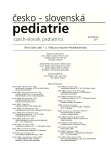-
Medical journals
- Career
Do we treate patients with cryptorchism at the recommended age?
Authors: D. Albertová; M. Drlík; P. Havránek
Authors‘ workplace: Klinika dětské chirurgie a traumatologie 3. LF UK a FTNsP, Praha přednosta prof. MUDr. P. Havránek, CSc.
Published in: Čes-slov Pediat 2011; 66 (2): 79-84.
Category: Original Papers
Overview
Boys with cryptorchism should be treated, according to the recommendation of the European Urological Society, treated up to 18 months of age. In spite of that numerous patients are operated on at later periods of time.
The aim of the study was to find out, how is the recommendation observed and reasons, why the part of the patients is operated on later. The results of the evaluation of our cohort indicate a continuing low awareness of the more stringent requirements for the time of the treatment. The hormonal therapy should not follow to delay of surgical therapy of cryptorchism. The ascensus of testis is not a rare disease. It is therefore necessary, within the framework of obligatory preventive examination, to examine the position of testis in scrotum.Key words:
cryptorchism, orchidopexis, ascensus of testis
Sources
1. Kočvara R. Kryptorchizmus: kdy načasovat a jakou léčbu provést? Urol List 2007; 5(1): 30–33.
2. Zeman L. Retence varlete. In: Šnajdauf J, Škába R. Dětská chirurgie. Praha: Karolinum, 2005 : 272–276.
3. Huff DS, Hadziselimovic, Snyder HM 3rd, et al. Histologic maldevelopment of unilaterally kryptorchid testes and thein descended partners. J Eur Pediatr 1993;152 (Suppl 2): S11–14.
4. Tekgül S, Riedmiller H, Gerharz E, et al. Guidelines of pediatric urology. In: European Association of Urology Guidelines. EAU, 2009 : 9.
5. Wood HM, Doder JS. Cryptorchidism and testicular cancer: separating fact from fiction. J Urol 2009; 181(2): 452–461.
6. Stec AA, Thomas JC, DeMarco RT, et al. Incidence of testicular ascent in boys with retractile testes. J Urol. 2007 Oct; 178(4 Pt 2): 1722–1724.
7. Mesrobian HG, Chassaignac JM, Laud PW. Presence or absence of an impalpable testi can be predicted from clinical observations alone. BJU Int 2002; 90(1): 97–99.
8. Lisá L. Nesestouplá varlata. Čes-slov Pediat 1996; 51 : 235–237.
9. Pyorala S, Huttunen NP, Ujati M. A review and meta-analysis of hormonal treatment of cryptorchidism. J Clin Endocrinol Metab 1995; 80 : 2795–2799.
10. Hadziselimovic F. Successful treatment of unilateral kryptorchid boys risking infertility with LH-RH analogue. Int Braz J Urol 2008 May–Jun; 34(3): 319–326.
11. Teyschl O, Tůma J. Využití laparoskopie při diagnostice, klasifikaci a léčbě nehmatného nesestouplého varlete. Rozhl Chir 2000; 79(11): 557–560.
12. Barthold JS, González R. The epidemiology of congenital cryptorchidism, testicular ascent and orchiopexy. J Urol. 2003 Dec; 170(6 Pt 1): 2396–2401.
Labels
Neonatology Paediatrics General practitioner for children and adolescents
Article was published inCzech-Slovak Pediatrics

2011 Issue 2-
All articles in this issue
- Reactive hyperemic index and endothelial dysfunction in children – pilot study
- Do we treate patients with cryptorchism at the recommended age?
- Extraesophageal reflux – otorhinolaryngological complication of gastroesophageal reflux
- How prevalent is being born small for gestational age? Analysis of 7341 children from the ELSPAC study population
- Cricopharyngeal achalasia, a rare cause of chronic irritable cough in infant
- In vitro efficacy of three novel delousing formulations against the head louse (Pediculus capitis L.)
- Serum neuron-specific enolase concentrations as a predictor of mortality in children with traumatic brain injury
- Czech-Slovak Pediatrics
- Journal archive
- Current issue
- Online only
- About the journal
Most read in this issue- Extraesophageal reflux – otorhinolaryngological complication of gastroesophageal reflux
- Do we treate patients with cryptorchism at the recommended age?
- Cricopharyngeal achalasia, a rare cause of chronic irritable cough in infant
- Reactive hyperemic index and endothelial dysfunction in children – pilot study
Login#ADS_BOTTOM_SCRIPTS#Forgotten passwordEnter the email address that you registered with. We will send you instructions on how to set a new password.
- Career

